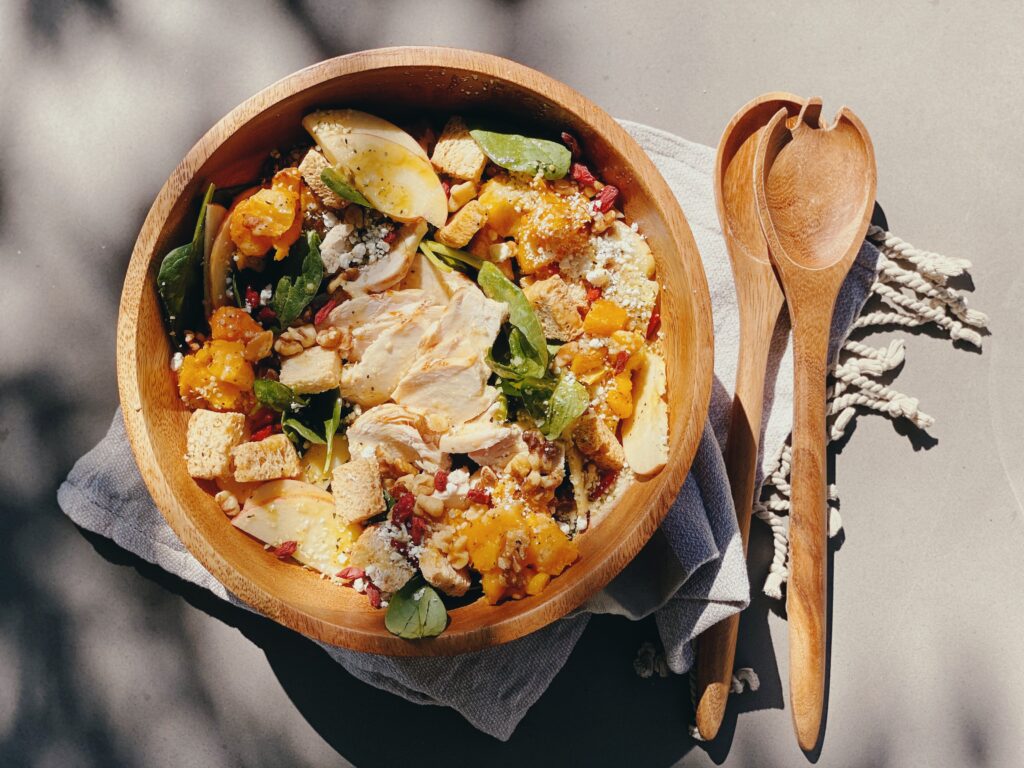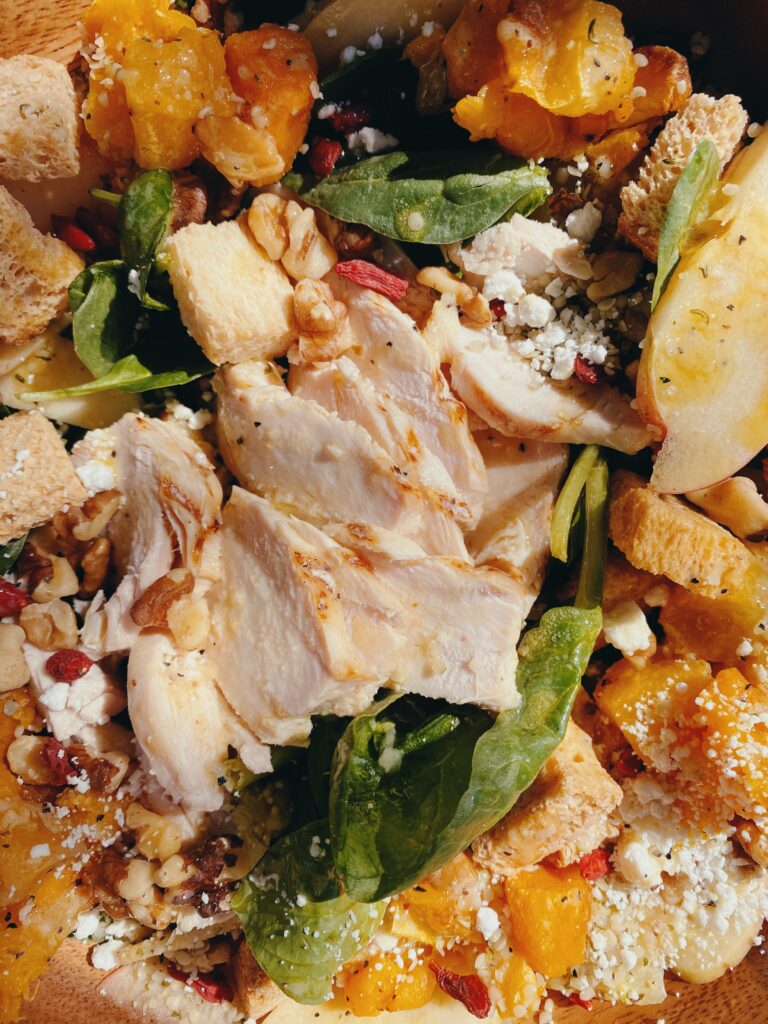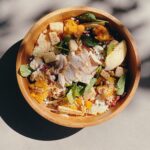This fall harvest salad is packed with a variety of autumn-inspired ingredients. It’s the perfect way to welcome October’s chillier temps. Seasonal and satisfying, this dish makes for a hearty lunch or light dinner—the kind of salad that leaves you feeling nourished from the inside, out. Packed with protein, tangy goat cheese, sweet apples, and a variety of healthy fats, it’s energizing nourishment with a fall flare. Best of all, it doesn’t break the bank. Use your pantry items to add bulk and flavor. Enjoy!

How to eat seasonally in the fall
We’re in the thick of September, and I find myself teetering between summer’s sweet, lighter fare and fall’s hearty, grounding ingredients. This time of year is the essence of the in between—mornings are glorious, but daylight is waning. And although afternoons are still warm, winter is on the horizon. It’s all a lesson in enjoying the here and now. When we can, we’ve been spending our weekends up in the mountains, relishing in summer’s fleeting metamorphosis. Inevitably, my cravings are following suit. I’m still buying pints of blueberries and pounds of peaches, but apples, pears, and purple cabbage are making their way into our kitchen. Raw, roasted, or steamed, these foods are a wonderful way to switch up repetitive meals and snacks. They’re also an easy way to diversify nutrition, especially when boosting immunity is key.
3 Filling salad tips
Yes, salads can be filling! It’s all about adding macro and micronutrients, a variety of textures, and a satisfying salad dressing. Unfortunately, the majority of meal salads are simply side salads in disguise. Say goodbye to that bag of iceberg lettuce, drizzled with flavorless, fat-free balsamic vinaigrette. It will ultimately leave you hungry an hour later. Why do many salads not hit the spot? Often, it’s because they don’t contain enough calories. They’re also lacking a solid mix of protein, fat, fiber, and carbs to keep you full for 3-4 hours. Here are three filling salad tips:
Don’t skimp on the carbs. In this fall chopped salad, I added butternut squash (starchy carb), apples (fruit), and croutons (complex carb). When in doubt, add a handful of seedy crackers or a slice of toasted bread. We need carbs in order to feel satiated.
Add at least two sources of fat. Here, I added goat cheese, chopped walnuts, and an olive oil-based salad dressing. Other options include avocado, olives, seeds, tahini, etc. Skip the inflammatory fats, like canola oil, and opt for extra-virgin olive oil. A salad with a variety of fats will immensely aid in satiation. Additionally, fat is needed for nutrient absorption. A study published in the American Journal of Clinical Nutrition found that participants who ate a salad with a fat-free dressing had almost no absorption of the nutrients alpha- and beta-carotene (precursors to vitamin A) and lycopene. However, those who had a fat-based dressing absorbed a much higher amount of these nutrients circulating.
Get enough protein. You want to aim for at keast 20 grams of protein per meal. If you’re adding poultry, eggs, tofu, or fish to your salad, it’s a lot easier to meet those protein needs. You can still get adequate protein for beans, peas, and legumes, just make sure you’re adding at least 3/4 cup.
how to make a fall chopped salad
This salad was born from a few pantry staples and an organic gala apple in our fridge. As with many of my recipes, feel free to swap ingredients or omit certain things. For example, feta cheese would be a delicious alternative to goat cheese. You can easily make this vegetarian by swapping the chicken breast for chickpeas (or baked tofu), and dried currants or raisins make for a delicious alternative to the goji berries. If you’re allergic to walnuts, omit entirely or use toasted pumpkin seeds instead.
Because this salad is best eaten at room temperature, I like to prepare the protein ahead of time, but as soon as your roasted butternut squash is done, begin assembling the salad. I like to roast the butternut squash cubes in avocado oil with sea salt, black pepper, onion powder, and garlic powder. For the croutons, I used Outside the Breadbox, a local Colorado company featuring delicious, gluten-free products.
what you need for this fall chopped salad
- Spinach – a light yet sweet salad base.
- Roasted butternut squash – creamy and delicious, butternut squash is one of my favorite starchy carbs.
- Chicken breast – providing protein and satiation, this is my go-to salad protein.
- Croutons – because every salad needs that crunch.
- Apple – I prefer honeycrisp or gala apples in this, but any red variety will do.
- Walnuts – for omega-3 fatty acids and texture.
- Goat cheese – part bittery, part buttery, I love goat cheese paired with butternut squash.
- Hemp seeds – incredibly nutritious, these seeds taste nutty and are packed with healthy fats.
- Goji berries – deliciously tart and immune-boosting, goji berries contain high amounts of vitamins A and C.



Fall Harvest Salad
Ingredients
Salad Base
- 4 cups spinach
- 1 cup cubed roasted butternut squash, warmed
- 1 cup chopped chicken breast, warmed
- 3/4 cup croutons (I used Outside the Breadbox)
- 1/2 apple chopped (any variety will do)
- 2 tablespoons chopped walnuts, toasted
- 1 tablespoon crumbled goat cheese
- 1 tablespoon hemp seeds
- 1 tablespoon goji berries
Salad Dressing
- 3 tablespoons extra-virgin olive oil
- 2 teaspoons white wine vinegar
- 1 teaspoon honey mustard
- 1/2 teaspoon garlic powder
- salt and pepper to taste
Instructions
- Assemble all ingredients, including preparing the chicken breast and butternut squash, chopping the apple and walnuts, etc.
- In a small sauce pan, toast chopped walnuts on low-to-medium heat (until fragrant; 2-3 minutes). Stir frequently to prevent burning.
- In a small bowl, combine all salad dressing ingredients. Whisk vigorously to combine. Set aside.
- In a large salad bowl, combine all salad ingredients, starting with the spinach. Layer on the roasted butternut squash, chopped chicken, etc.
- Pour dressing on top of salad, mix to combine, and enjoy.
Notes



Leave a Reply